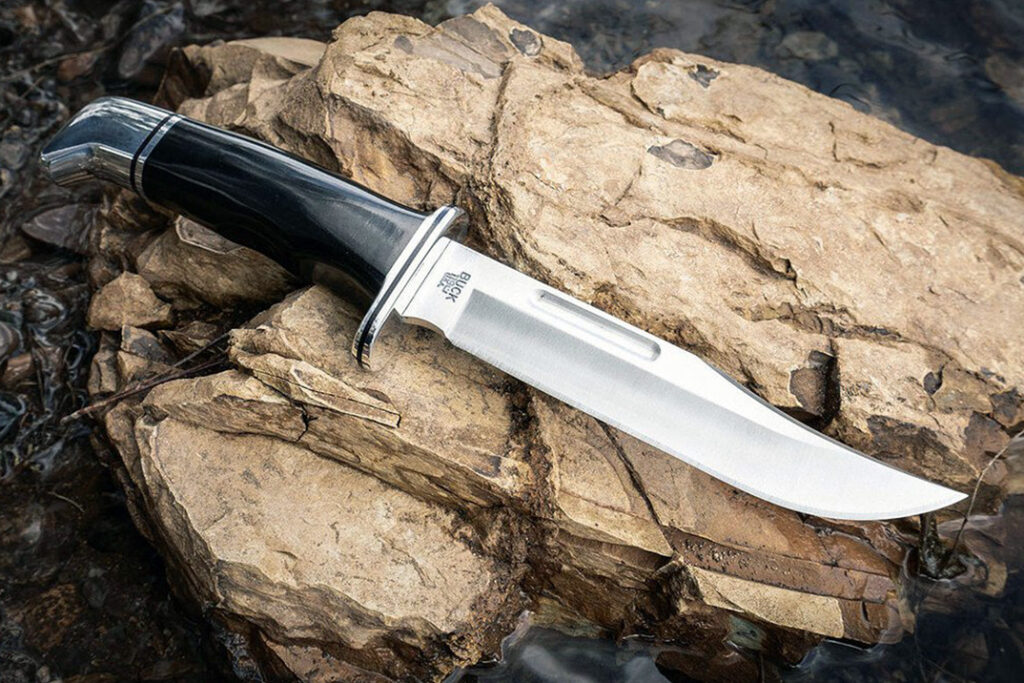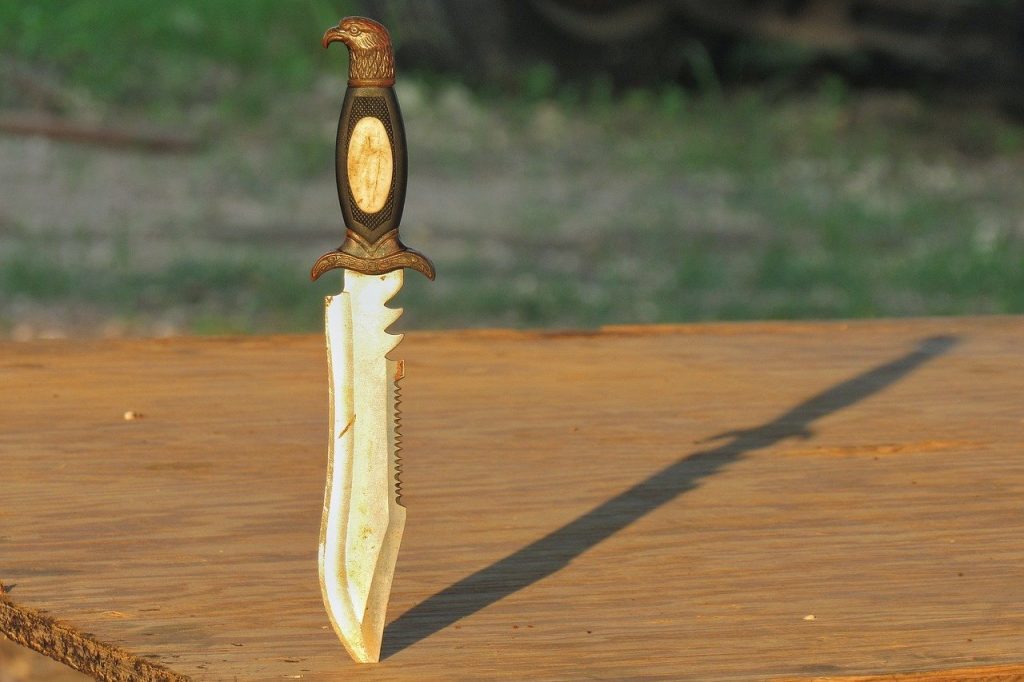The Bowie knife is legendary among knives. The Bowie knife symbolises workmanship and practicality due to its unique design and long history. Bowie knives—what are they?
This detailed book explores the origins, attributes, applications, and significance of this legendary blade. Join us on a fascinating tour of the Bowie knife, whether you’re a fan or just curious.
What is a Bowie Knife?
Large, fixed-blade Bowie knives have a clip point and crossguard. Early 19th-century frontiersman Jim Bowie popularised it.
Bowie knives usually have blades between 6 and 12 inches (15 to 30 cm) long and 1.5 to 2 inches (4 to 5 cm) wide. Wood, bone, or other sturdy materials make up the handle.
Bowie knives are versatile and strong. Hunting, camping, and self-defense are possible with its sturdy build and keen blade. In the hands of an experienced user, the Bowie knife can cut, thrust, and slash precisely.
The Fascinating History of Bowie Knives
Jim Bowie’s life is linked to the Bowie knife’s. Jim Bowie, born in Kentucky in 1796, was a major figure in the Texas Revolution and the Sandbar Fight.
Jim Bowie supposedly created the first Bowie knife by combining the greatest qualities of Spanish hunting knives, French butcher knives, and other blades he encountered on his travels.
Jim Bowie’s Sandbar Fight defence made the knife famous. This incident made the Bowie knife famous in America.
Notable Features of a Bowie Knife

Bowie knives have unique features. Features include:
Clip Point: Bowie knives are known for their clip points. The concave curvature near the blade tip improves control and piercing.
Crossguard: Bowie knives have handguards, or crossguards. This metal plate between the blade and handle prevents the user’s hand from sliding onto the deadly edge.
Full Tang Construction: The blade extends through the handle of most Bowie knives, giving strength and stability.
Guard and Pommel: Bowie knives have a crossguard, guard, and pommel. Between the blade and handle is the guard. It balances the knife and protects the user’s hand during rigorous use.
The handle’s pommel is rounded or flared. Its aesthetics and counterweight help control and balance the blade.
Blade Material: Bowie knives are comprised of durable, edge-retaining steel. Damascus, carbon, and stainless steel are blade materials. Personal desire and special needs determine the material.
Handle Design: Bowie knives have ergonomic handles. Its natural materials like wood, bone, and antler make it attractive. G-10 or Micarta handles on modern Bowie knives improve grip and durability.
Popular Types and Variations of Bowie Knives

Bowie knives have evolved into many styles and varieties. Popular ones:
Classic Bowie Knife: This is the classic Bowie knife, modelled after Jim Bowie’s blade. It has a long, strong blade with a clip point and a hand guard.
Trailing Point Bowie: This variety has a sweeping, curved blade with an upward-pointing tip. Hunters like this knife’s slicing and skinning ability.
Straight Back Bowie: Unlike the clip point, the straight back Bowie has a straight edge from handle to blade. It’s strong and versatile enough for survival and heavy-duty operations.
Folding Bowie Knife: Traditional Bowie knives are fixed-blade. These folding knives are convenient for everyday carry because the blade may be safely tucked into the grip.
Custom Bowie Knives: Many knife aficionados want custom Bowie knives. Collectors prize these knives for their complex features, high-quality materials, and unusual designs.
Choosing the Right Bowie Knife for Your Needs

To find the appropriate Bowie knife, consider various aspects. Key considerations:
Intended Use: The knife’s main use. Hunting, camping, or self-defense? Clarifying your intended use will help narrow the alternatives.
Blade length: Consider your needs. Longer blades reach farther and chop harder, while shorter blades are easier to handle.
Blade Material: Blade material impacts longevity, sharpness retention, and corrosion resistance. Choose a blade material that suits your preferences and usage by researching its qualities.
Handle Comfort: Consider handle design and material. Check for comfort and grip. Ergonomic and textured handles improve control and decrease slippage.
Budget: Set a Bowie knife budget. Brand, materials, craftsmanship, and features affect Bowie knife prices. Determine your budget for a high-quality Bowie knife that suits your needs.
Brand Reputation: Consider brand or manufacturing repute. Reputable brands make quality knives. Check customer reviews to assess the brand’s quality and satisfaction.
Maintenance Requirements: Bowie knives require different upkeep. Some blades need rust prevention, while others need honing. Make sure the maintenance requirements match your time and effort.
Legalities: Know your local knife laws. Certain governments may limit bowie knives due to their big blades. Use a Bowie knife legally.
How to Properly Care for Your Bowie Knife

Maintaining your Bowie knife is essential for its longevity and functionality. Maintain your knife with these tips:
Cleaning: Clean your Bowie knife with warm water and mild soap after each usage. Avoid rust by drying the blade.
Sharpening: Keep the blade sharp. Sharpen with a stone or rod. Follow the manufacturer’s blade steel sharpening instructions.
Lubrication: Apply a thin layer of lubrication or oil to the blade to prevent corrosion and maintain folding Bowie knife moving parts. Use knife-specific lubricant sparingly.
Storage: Sheath or cover your Bowie knife while not in use. This prevents inadvertent damage and keeps the blade dry.
Avoid Excessive Force: Bowie knives are strong, so avoid misusing them. Misuse damages blades and causes injuries.
The Practical Uses of a Bowie Knife
Bowie knives are multipurpose. Bowie knives are used for:
Outdoor and Survival Activities: Campers, hikers, and survivalists love Bowie knives. They can cut ropes, prepare firewood, create shelters, and hunt.
Hunting and Skinning: Bowie knives are ideal for hunting and skinning due to their strong blades. The clip tip pierces and guts, and its adaptability allows accurate cuts.
Bushcraft and camping: Bowie knives can be used for carving, notching, feathering, and meal preparation. It’s rugged and trustworthy in the woods.
Self-Defense and Personal Protection: Bowie knives are large, strong, and scary. However, self-defense firearm use must follow local rules. If you use a Bowie knife for self-defense, you need self-defense training.
Culinary Purposes: Bowie knives can be used in cooking. Chopping, slicing, and dicing ingredients is easy with their huge size and sharp blades, especially when cooking outside or without specialised kitchen utensils.
Collecting and Displaying: Bowie knives’ beauty and history draw collectors. Bowie knife collectors enjoy their craftsmanship, variety, and unique designs. These knives lend historical character to any collection.
Utility and Tool Applications: Bowie knives are useful in many circumstances due to their versatility. It cuts ropes, opens parcels, clears undergrowth, and other activities that demand a strong, sharp blade.
Bowie Knife in Pop Culture and Literature
Popular culture and literature have immortalised the Bowie knife. Movies, novels, and mythology have immortalised it. Pop culture references to the Bowie knife include:
Literature: The Bowie knife appears in western novels. Cowboys, explorers, and adventurers commonly wear it. Zane Grey and Louis L’Amour eloquently described Bowie knife use.
Movies: The Bowie knife is famous for its film appearances. In “Crocodile Dundee,” the main character utilises a Bowie knife to fight armed intruders, demonstrating the weapon’s strength and versatility.
Folklore & Legends: Jim Bowie, a larger-than-life personality, has inspired many Bowie knife tales. Knives symbolise strength, skill, and survival in these stories.
Famous personalities have owned and used Bowie knives. Famous Bowie knife users:
Famous Bowie Knife Owners Throughout History

Jim Bowie: The inventor of the Bowie knife, Jim Bowie is the most famous person associated with it. His usage of the knife in the Sandbar Fight made him famous and immortalised the knife.
Colonel James “Jim” Bowie: Jim Bowie’s brother was a key Texas Revolution figure. He uses a Bowie knife to demonstrate its combat efficiency.
Colonel James “Jim” Bowie: Rezin P. Bowie, another brother of Jim Bowie, helped sell the Bowie knife. He helped establish the knife’s reputation and design.
Rezin P. Bowie: William “Bill” Bowie, Jim Bowie’s cousin, also used the Bowie knife. He crafted and designed Bowie knives, boosting their fame.
Frontiersmen & Explorers: Davy Crockett, Kit Carson, and other American West pioneers carried Bowie knives for survival. These famous adventurers popularised Bowie knives.
William “Bill” Bowie: Military figures have always used Bowie knives. Both sides of the Civil War carried Bowie knives as auxiliary weapons. Nathan Bedford Forrest was famous for his Bowie knife use in warfare.
Frontiersmen and Explorers: Survivalists and outdoor enthusiasts have popularised the Bowie knife recently. Bear Grylls and Ray Mears, among others, have demonstrated the versatility and utility of Bowie knives on television.
Questions (FAQs)
Carry Bowie knives?
Bowie knives are permitted in some jurisdictions. Know your local knife ownership and carry laws.
Bowie knives for self-defense?
Bowie knives’ size and strength make them suitable for self-defense. However, self-defense regulations vary, and any weapon used for self-defense must be legal and used appropriately.
What hunting Bowie knife should I get?
Consider blade length, material, grip comfort, and use when choosing a hunting Bowie knife. Find a knife for skinning, field dressing or basic hunting duties.
How do I maintain my Bowie knife?
Clean, dry, and lubricate the blade regularly. Sharpen the knife and keep it in a sheath. Avoid severe temperatures and moisture with the knife.
Bowie knives for cooking?
Bowie knives can be used for cooking, especially outdoors. They can chop, slice, and prepare food due to their size and sharp blades.
Can I collect and exhibit Bowie knives?
Absolutely! Bowie knives are collected for their historical and aesthetic value. Displaying and conserving vintage knives is a wonderful hobby that shows their artistry.
Conclusion
In conclusion, the Bowie knife is revered in history, popular culture, and knife lovers. Its clip-point blade, guard, and pommel make it flexible and iconic.
For its usefulness and historical significance, the Bowie knife is valued for hunting, self-defense, outdoor activities, and collecting.
Consider affordability, blade length, grip comfort, and use when choosing a Bowie knife. Bowie knives need regular maintenance to last and perform well.
